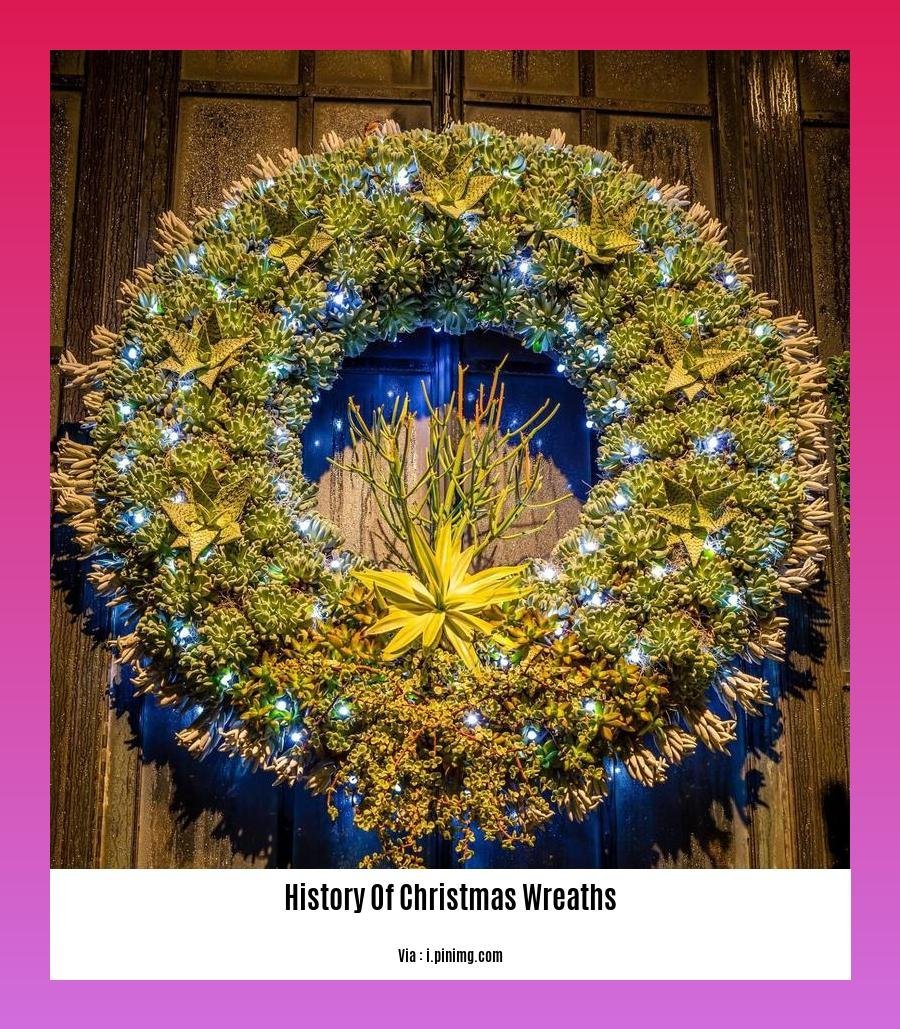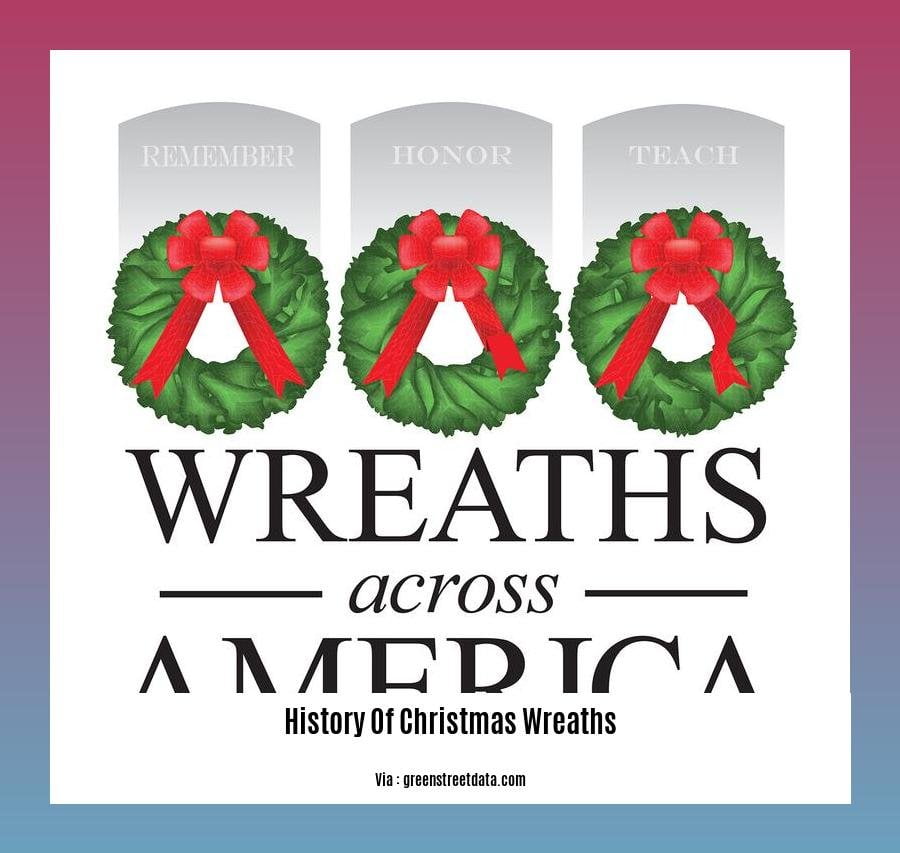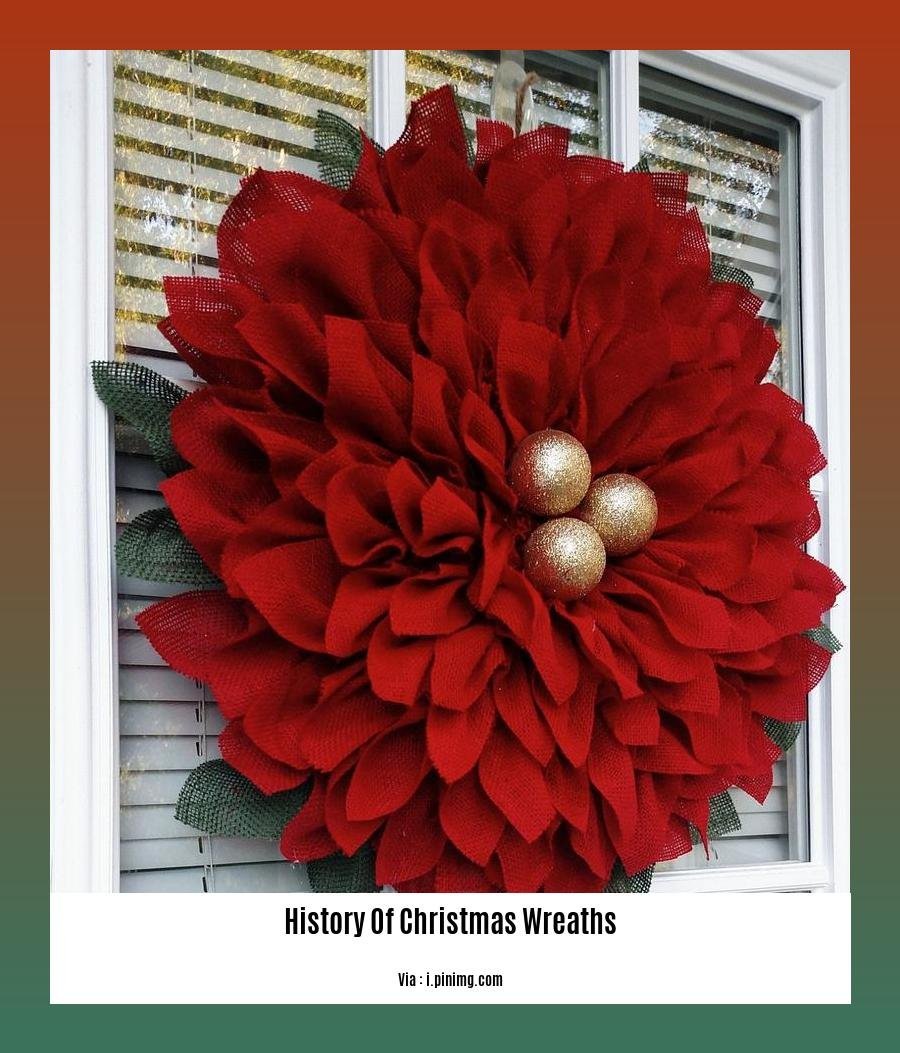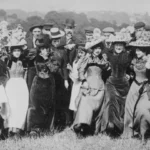Step into the captivating history of Christmas wreaths, a tradition that has woven its way through centuries, cultures, and countless holiday celebrations. From ancient pagan rituals to modern-day festive décor, these vibrant adornments hold a wealth of stories, symbols, and seasonal cheer. Join us on a journey through time as we unravel the fascinating origins, evolution, and cultural significance of these beloved holiday icons in our article titled [Unraveling the History of Christmas Wreaths: A Journey Through Time].
Key Takeaways:
- Christmas wreaths have ancient origins, tracing back to the Celts’ use of holly boughs to celebrate the Winter Solstice.
- In ancient Rome, victorious warriors wore wreaths (“coronas”) as symbols of honor.
- The term “wreath” originates from the Old English word “writhan,” meaning “to twist,” and has been used in various cultures throughout history.
The History of Christmas Wreaths: A Celebration of Traditions and Symbolism

The Christmas wreath, a beloved symbol of the holiday season, is steeped in a rich history that dates back to ancient times. Its evolution through different cultures has resulted in a variety of traditions and meanings associated with this festive decoration.
Origins of the Christmas Wreath
The origins of the Christmas wreath can be traced back to the ancient Celts, who dwelled in Europe during the Iron Age. They celebrated the Winter Solstice by decorating their homes with boughs of holly, which symbolized life and protection during the dark winter months.
Roman Influence
Victorious warriors in ancient Rome adorned themselves with wreaths or “coronas” as symbols of honor and achievement. These wreaths were made from laurel branches and were believed to bring good fortune and protection.
Evolution of the Wreath in Christianity
Early Christians adopted the tradition of the wreath, using it to symbolize the everlasting love and life of Jesus Christ. Green wreaths adorned with red berries (representing the blood of Christ) became popular, and the circular shape symbolized eternity.
Christmas Wreaths in Germany
In Germany, during the Middle Ages, the Christmas wreath was transformed into the Advent wreath. This wreath featured four candles, each representing one of the four weeks of Advent. The lighting of each candle marked the passing of a week and brought the Christmas celebration closer.
Spread of the Christmas Wreath Tradition
From Germany, the Christmas wreath tradition spread throughout Europe and eventually made its way to the Americas. In the United States, the wreath became a symbol of holiday cheer and goodwill, often adorned with lights, ornaments, and bows.
Wreaths Across America
Today, the Christmas wreath is a cherished symbol of the holiday season, representing joy, peace, and the spirit of giving. The tradition of Wreaths Across America, where wreaths are placed on the graves of veterans and fallen soldiers, is a poignant reminder of the sacrifices made by those who served our country.
Conclusion
The history of Christmas wreaths is a rich tapestry of cultural influences, religious symbolism, and holiday traditions. From its humble origins in ancient times to its role as a cherished symbol of the Christmas season, the wreath continues to hold a special place in our hearts and homes during the holidays.
Did you know the custom of lighting up Christmas trees started way back in the Middle Ages when fir trees were used to celebrate religious winter festivals? Head over to the history of Christmas lights page to find out more about the background of the beloved Christmas decoration.
Christmas trees aren’t complete without the shiny baubles hanging from them. Unwrap the fascinating history of Christmas ornaments and learn about the evolution of these enchanting decorations.
Do you know that the fast food industry has a long and winding history? Indulge yourself in the history of fast food and discover how this global phenomenon came to be.
Over time, wreaths evolved with the incorporation of lights, ribbons, and ornaments, becoming a symbol of festivity and joy.
Throughout history, Christmas wreaths have evolved into beautiful symbols of joy and celebration. Originally used by ancient cultures to represent eternal life and ward off evil spirits, these circular decorations were adopted by early Christians to symbolize Christ’s victory over death.
The circle shape signifies eternity, while the greenery stands for new life and growth.
Over time, wreaths evolved with the incorporation of lights, ribbons, and ornaments, becoming a symbol of festivity and joy. In the 19th century, they became popular Christmas decorations in homes and businesses, spreading from Germany throughout Europe and eventually to the Americas.
Nowadays, Christmas wreaths are cherished symbols of the holiday season, representing joy, peace, and the spirit of giving.
Key Takeaways:
- Ancient cultures used wreaths to symbolize eternal life and rebirth, hanging them on doors and windows to ward off evil spirits.
- Early Christians adopted the wreath as a symbol of Christ’s victory over death and resurrection, hanging them in churches and homes during Christmas.
- The circular shape of the wreath represents eternity and the never-ending cycle of life and death, while the greenery symbolizes new life and growth.
- Wreaths are often decorated with ribbons, bells, and other festive ornaments and are a popular way to add a touch of holiday cheer to homes and businesses.
- Today, the wreath has become a symbol of Christmas around the world and is a popular tradition that is enjoyed by people of all faiths.
Sources:
The History of the Christmas Wreath
Christmas Wreath History and Symbolism
In many cultures, wreaths were used to decorate homes, churches, and community spaces during the holiday season, creating a sense of unity and celebration.

During the holidays, it feels good to drive along a road donned with Christmas lights, and admire the yards that have crafted intricate winter wonderlands. However, there’s one decoration that often goes unnoticed – the Christmas wreath.
This ubiquitous symbol of the season holds a history that’s both rich and heartwarming. In many cultures, wreaths were not just decorations but symbols of unity, celebration, and even protection.
- Ancient Rome:
Victorious Roman soldiers were honored with wreaths made from laurel branches – a symbol of triumph and achievement.
- Middle Ages Germany:
The evergreen Christmas wreath, as we know it today, originated here. It represented eternal life and was often hung in homes during the Advent season.
- Victorian England:
Wreaths were a quintessential part of Victorian Christmas decor. They were festooned with evergreens, holly, and mistletoe, bringing a touch of nature indoors.
- Colonial America:
The tradition of Christmas wreaths traveled across the Atlantic with the European settlers. They used local evergreens and berries to create their own unique wreaths.
- Modern Times:
Today, wreaths are ubiquitous during the holiday season. They adorn homes, churches, and public spaces, creating a sense of cheer and festivity.
The Christmas wreath is more than just a decoration. It’s a symbol of our shared history and a reminder of the joy and unity that the holiday season brings.
Key Takeaways:
Wreaths have been used as decorations for centuries, with roots in ancient Rome and the Middle Ages.
Initially, wreaths were made from laurel branches, evergreens, holly, and mistletoe.
In Victorian England, wreaths became an essential part of Christmas decor, often adorned with festive ornaments.
European settlers brought the tradition of Christmas wreaths to colonial America, using local evergreens and berries.
Today, wreaths are a global symbol of the holiday season, representing joy, unity, and a sense of celebration.
Citations
– History of the Christmas Wreath
– Christmas Wreaths: Origins and Symbolism
Today, Christmas wreaths are a cherished tradition, embodying the spirit of the season and bringing joy and festivity to homes around the world.
Evergreen boughs, glistening with festive decorations, hang on doors, windows, and fireplaces, symbolizing warmth, hospitality, and the spirit of giving. How did these beautiful wreaths become such an integral part of our holiday celebrations? Let’s take a journey through time to uncover their fascinating history.
A Brief History of Christmas Wreaths
As you wander through the aisles of a Christmas store, marveling at the array of wreaths, you might wonder about their origins. These beloved holiday decorations can trace their roots back to ancient times, when the Celts, Romans, and early Christians used wreaths to mark special occasions and celebrate the changing seasons.
The Celts believed that evergreens symbolized eternal life, so they adorned their homes with wreaths during the winter solstice to promote good fortune and ward off evil spirits. In ancient Rome, victorious warriors were honored with wreaths made of laurel leaves, a symbol of their achievements.
Early Christians adopted the wreath as a symbol of Christ’s victory over death and resurrection. They hung wreaths made of evergreens, representing everlasting life, and decorated them with red berries, symbolizing the blood of Christ.
The Evolution of Christmas Wreaths
Over the centuries, the Christmas wreath underwent several transformations. In the Middle Ages, the Advent wreath emerged in Germany, featuring four candles representing the four weeks leading up to Christmas.
During the Victorian era, wreaths gained popularity as festive decorations. They were adorned with holly, mistletoe, ribbons, and bells, reflecting the spirit of the season. The tradition of hanging wreaths on doors became widespread, symbolizing welcome and hospitality.
Christmas Wreaths Today
Today, Christmas wreaths are a cherished tradition that brings joy and festivity to homes around the world. They come in various shapes, sizes, and designs, each reflecting the unique style of the homeowner. From traditional evergreens to modern minimalist wreaths, there’s a wreath to suit every taste.
Key Takeaways
- Christmas wreaths originated from ancient traditions, symbolizing eternal life, victory, and the spirit of the season.
- Early Christians adopted the wreath as a symbol of Christ’s victory over death and resurrection.
- The Advent wreath, featuring four candles, emerged in Germany during the Middle Ages.
- During the Victorian era, wreaths gained popularity as festive decorations, adorned with holly, mistletoe, ribbons, and bells.
- Today, Christmas wreaths are a cherished tradition, representing joy, peace, and the spirit of giving.
Sources
- The History of the Christmas Wreath
- Christmas Wreath History and Symbolism
FAQ
Q1: What is the origin of Christmas wreaths?
A1: The tradition of Christmas wreaths can be traced back to ancient times, with the Celts using holly boughs to celebrate the Winter Solstice and the Romans using wreaths as symbols of honor and victory.
Q2: What is the symbolism behind the Christmas wreath?
A2: The circular shape of the Christmas wreath represents eternity and the never-ending cycle of life and death, while the greenery symbolizes new life and growth.
Q3: How did the Christmas wreath become associated with Christianity?
A3: Early Christians adopted the wreath as a symbol of Christ’s victory over death and resurrection, and began hanging them in churches and homes during the Christmas season.
Q4: What are some popular decorations used on Christmas wreaths?
A4: Christmas wreaths are often decorated with ribbons, bells, and other festive ornaments, such as holly berries, pine cones, and candy canes.
Q5: What is the significance of wreaths in different cultures?
A5: Wreaths have been used in various cultures throughout history, symbolizing everything from eternal life to good luck and protection from evil spirits.









